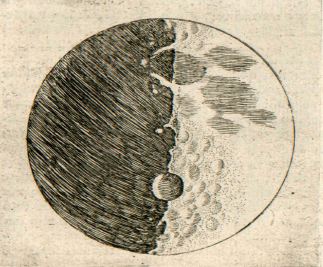Galileo's discoveries around Jupiter
by
Philippe Jeanjacquot
—
last modified
Jul 13, 2012 04:11 PM
Introduction
This session used the Galileo’s book : « Sidereus Nuncius ». We can find the original text and the French translation on the website of the observatory of Lyon.
The aim of this activity is to simulate the Galileo’s discovery when he observed Jupiter and understand his approach. For the simulation we used Stellarium software.
This activity takes place after the study of the Ptolemaic system, the Greek philosophers (Thales, Socrates, Plato and Aristostle), their science approach and their conception of the Universe.
Before, the activity, we talk about the book.

Galileo probably has his telescope in 1609. He shows it to his patron the 21 of August. He published « Sidereus Nuncius » the 8 of Marsh 1610.
In this short book (the translated book has approximately 50 pages), he explained:
- His Moon observations. He discovered that the Moon is not smooth and not perfect as the Aristotelian said. In fact, during the 17th century most of the university and the religious were Aristotelian and they believe than the sky was divine and perfect.
Galileo saw mountains and craters and the surface of the Moon. He gave also a method to measure their elevation
Galileo saw mountains and craters and the surface of the Moon. He gave also a method to measure their elevation
- With his telescope he found a lot of new stars and drew them in Orion and in the Pleiades
- But the most important discovery was made the 7 of January 1610…
During the explanations we show a duplication of the Galileo’s telescope.

We gave this first part of the text to the pupils.
I. Summary
400 years ago, Galileo has done with his telescope a series of observations of Jupiter. We will put ourselves in the same conditions (virtual). To do this we will use the software "Stellarium.
We will note our observations, write the hypothesis that we can make observations and build an experimental protocol to check our hypothesis.
We will note our observations, write the hypothesis that we can make observations and build an experimental protocol to check our hypothesis.
II. imput new parameters of Stellarium
Open Stellarium
Choose: the place of observation: Padova
Date January 7, 1610 Time: (1 hour after sunset)
Remove the names of planets.
Stellarium opens when the vision of heaven when we place ourselves at 40cm from the screen corresponds to the vision of the sky with the naked eye. Write the FOV (field of view)
Stellarium opens when the vision of heaven when we place ourselves at 40cm from the screen corresponds to the vision of the sky with the naked eye. Write the FOV (field of view)
III. first observation.
Find Jupiter.
Galileo observed Jupiter with his telescope with a magnification of 30. Zoom in on Jupiter until the FOV is 30 times smaller than that seen initially. Then, you observe Jupiter as Galileo did 400 years ago. Record your observations. (Using the model we have established during the session on the observation). What hypothesis can we deduct from that first comment?
THE TWO OTHER DECISIVE OBSERVATIONS
Galileo observed Jupiter again: On January 8 (without specifying the time of observation) and January 10 (the ninth day, the sky was cloudy. Represent your comments. What hypothesis are you making from these observations? Propose an experiment to test these hypotheses.
Help to the pupils and analysis
If the pupils followed advises of the observation session they write that they see white dots around Jupiter. If not, they can say directly that the see the satellites of Jupiter.
We can help them and recall them that in the 17th century the heliocentrism and Copernicus’ thesis was not accepted by the university community. Nevertheless, Copernicus book the “De revolutionibus orbium coelestium” was published in 1543. But the scholars keep the geocentrism and the Ptolemaic thesis. In this sight of the Universe the Sun the Moon and the five planets turn around the Earth and the Star were set on the cosmic sphere. The satellites does not exist for the geocentrism theory.
We corrected this part and then gave this second part to the pupils
VI. Galileo's drawings :
the 7th of January1610 1hour after the sunset.

the 8th of January1610

« …the three little stars were in the west of Jupiter, closer to each other as the night before, separated by equal intervals… » Galileo, Sidereus Nuncius
the 9th of January1610: Cloudly, no observations.
the 10th of January1610

« There were only two, both to the east, the third being hidden, as I supposed, after Jupiter. » Galileo, Sidereus Nuncius
* The sleep walkers, Koestler
Document Actions

